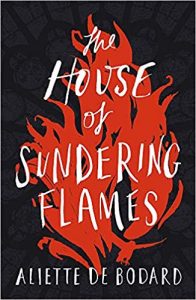Gary K. Wolfe Reviews The House of Sundering Flames by Aliette de Bodard
 The House of Sundering Flames, Aliette de Bodard (Gollancz 978-1-47322-340-0, £16.99, 560pp, tp) July 2019. (JABberwocky Literary Agency 978-1-625674-61-6, $16.00, 386pp, tp) September 2019.
The House of Sundering Flames, Aliette de Bodard (Gollancz 978-1-47322-340-0, £16.99, 560pp, tp) July 2019. (JABberwocky Literary Agency 978-1-625674-61-6, $16.00, 386pp, tp) September 2019.
I’m sure that someone, somewhere, has pointed out a possible relationship between fantasy trilogies and the structure of classical sonatas or symphonies, with the final movement recapitulating major themes while accelerating the pace and leading toward an aggressively dramatic climax, but Aliette de Bodard’s Dominion of the Fallen series, which concludes with The House of Sundering Flames, makes a better case for this than most. After introducing us to a spectacular ruined Paris, decades after a catastrophic war among fallen angels (or just Fallen) in The House of Shattered Wings, she complicated matters considerably by introducing (and shifting much of the action to) a hidden dragon kingdom underneath the Seine in The House of Binding Thorns, with the specter of Vietnamese colonial history hanging over both settings, represented by the Annamite community of exiles which coexists with the Houses in Paris. With The House of Sundering Flames, she keeps most of the action on the surface, where the various competing “houses” have arrived at a tentative accommodation with each other, after House Silverspires was badly weakened in the first novel and House Hawthorn nearly destroyed by dragon ice in the second. Now Hawthorn is governed by two rulers, the result of a politically convenient – but as it turns out, pretty passionate – marriage between the dragon prince Thuan and the Fallen Asmodeus. We’re not even halfway through Chapter One before this precarious peace is literally shattered by the explosion of House Harrier, so close to Hawthorn that Hawthorn itself is badly damaged in the blast.
Just as The House of Shattered Wings began with a kind of murder mystery set in House Silverspires, we’re now confronted with the mystery of who blew up Harrier, and whether the other Houses may be in similar danger. One early suspect is a new figure, Dân Chay, an avatar of chaos and an Immortal “from a time before justice, before fairness,” who seeks revenge on all humanity, but who has been missing for decades. While Dân Chay makes a spectacular and apparently unstoppable villain later on, the full story turns out to be a lot more complicated, and involves several of the major characters we’ve come to know from the earlier volumes. Not only Asmodeus and Thuan (whose testy marriage is one of more mundane delights of the novel), but Emmanuelle (the partner of Silverspires’ head Selene), who is trapped in Harrier during the explosion but loses her memory of what led up to it; Philippe, the immortal Annamite who earlier brought the Fallen Isabelle back to life; Isabelle, now a mortal and Philippe’s roommate; Aurore, a poor Houseless Parisian who is sent on a particularly cruel mission by Asmodeus but simply wants to find her way back to her sister Cassiopée; and a varied and sometimes daunting cast of secondary characters ranging from functionaries of the various Houses to the houseless citizens and Annamite caught in the crossfires of supernatural battles.
And those battles do get spectacular. A climactic confrontation (between whom, I shouldn’t say) late in the novel is as enthusiastically symphonic as anything I’ve read in recent fantasy, even though a lot of it seems to involve luminescent threads of power snaking across the landscape and people chucking various sorts of spells at one another. De Bodard has a marvelous visual imagination, though, giving us stunning images ranging from Thuan’s own dragon form (which he lapses into at critical times), to an emissary from the dragon kingdom who can disassemble into flower petals, to some genuinely creepy thorn-children and some really angry birds. While the spectacle satisfies even as it goes on a bit, the real resolution of this fascinating trilogy returns us to where it began – with de Bodard’s complex, rich, and conflicted characters trying to come to terms with family, loyalty, honor, exile, and power in a setting at once wildly romantic and existentially bleak, just as the real Paris could accommodate the world views of both Victor Hugo and Sartre. After the already-ruined city gets walloped again here, though, let’s hope those characters find some sort of equipoise. As story-rich an environment as the Dominion of the Fallen may be, Paris can’t take much more of this.
Gary K. Wolfe is Emeritus Professor of Humanities at Roosevelt University and a reviewer for Locus magazine since 1991. His reviews have been collected in Soundings (BSFA Award 2006; Hugo nominee), Bearings (Hugo nominee 2011), and Sightings (2011), and his Evaporating Genres: Essays on Fantastic Literature (Wesleyan) received the Locus Award in 2012. Earlier books include The Known and the Unknown: The Iconography of Science Fiction (Eaton Award, 1981), Harlan Ellison: The Edge of Forever (with Ellen Weil, 2002), and David Lindsay (1982). For the Library of America, he edited American Science Fiction: Nine Classic Novels of the 1950s in 2012, with a similar set for the 1960s forthcoming. He has received the Pilgrim Award from the Science Fiction Research Association, the Distinguished Scholarship Award from the International Association for the Fantastic in the Arts, and a Special World Fantasy Award for criticism. His 24-lecture series How Great Science Fiction Works appeared from The Great Courses in 2016. He has received six Hugo nominations, two for his reviews collections and four for The Coode Street Podcast, which he has co-hosted with Jonathan Strahan for more than 300 episodes. He lives in Chicago.
This review and more like it in the December 2019 issue of Locus.
 While you are here, please take a moment to support Locus with a one-time or recurring donation. We rely on reader donations to keep the magazine and site going, and would like to keep the site paywall free, but WE NEED YOUR FINANCIAL SUPPORT to continue quality coverage of the science fiction and fantasy field.
While you are here, please take a moment to support Locus with a one-time or recurring donation. We rely on reader donations to keep the magazine and site going, and would like to keep the site paywall free, but WE NEED YOUR FINANCIAL SUPPORT to continue quality coverage of the science fiction and fantasy field.







